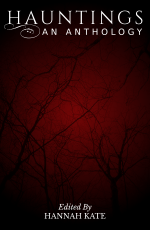Hannah Kate's Blog, page 76
November 24, 2014
North Manchester FM: Community Train, Tuesday 25 November 2014
So, I’m currently training to be a presenter on North Manchester FM (my local radio station). Once I’ve learnt the ropes, I’ll be hosting a literature show on Saturdays 4-6pm. For the next couple of weeks, though, I’m going to be on Community Train and it would be great if you could listen along or say hi on Twitter (@norman1066).
This week, I’m going to be chatting to Dr Chris Monk, a research consultant who specializes in all things Anglo-Saxon. Chris is a friend of mine from the University of Manchester, where we both completed our PhDs. You can find out more on Tuesday 25th, when I’ll be talking to Chris and finding out more about his recent work.
You can listen to the show live online or old school (if you’re in North Manchester) on 106.6FM. Hope you enjoy the show!
October 18, 2014
6 Things I’ve Learned from Reading Penny Dreadfuls
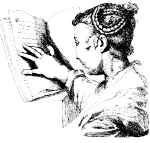 As you might know, I’ve recently been editing the Digital Periodicals series for Hic Dragones: new serialized eBook editions of classic Victorian penny dreadfuls. Penny dreadfuls (or penny bloods, as they’re also known) were long-running sensational stories, sold for a penny an issue in cheap, pulp newspapers and pamphlets. I estimate that I’ve now edited and formatted around 750,000 sensational words and read around a million more (penny dreadfuls are pretty epic in their length!), so I thought I’d share with you some of the important lessons I’ve learned from my plunge into lurid Victoriana…
As you might know, I’ve recently been editing the Digital Periodicals series for Hic Dragones: new serialized eBook editions of classic Victorian penny dreadfuls. Penny dreadfuls (or penny bloods, as they’re also known) were long-running sensational stories, sold for a penny an issue in cheap, pulp newspapers and pamphlets. I estimate that I’ve now edited and formatted around 750,000 sensational words and read around a million more (penny dreadfuls are pretty epic in their length!), so I thought I’d share with you some of the important lessons I’ve learned from my plunge into lurid Victoriana…
1. It’s not all about madwomen in the attic
If I say the words ‘Victorian’ and ‘madness’, what’s the first thing that comes to mind? Possibly Mr Rochester’s poor first wife in Jane Eyre, locked away in an attic so that her husband is able to bigamously marry a ‘more suitable’ match. Or maybe you think of spinsters, widows and outspoken women, cast aside by their families and locked away in lunatic asylums to keep them out of sight and out of the way.
There are a lot of references to lunatic asylums in penny dreadfuls, and they are as ominous and creepy as you would expect. What might come as a surprise is that the inmates are – on the whole – men. They are middle class men who have been locked away by relatives for financial reasons.
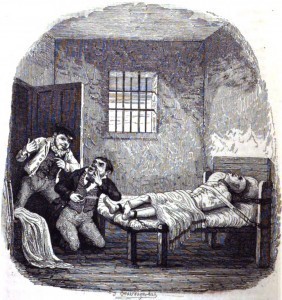
from The Life and Adventures of Valentine Vox, the Ventriloquist
The Life and Adventures of Valentine Vox, the Ventriloquist has probably the most extended treatment of this theme. The 1840 complete edition of the text even includes a wonderfully polemical introduction written by the author, which condemns recent changes in the law that allows for people to be incarcerated in private asylums on the loosest of medical evidence.
The asylum subplot in Valentine Vox is treated very seriously – despite the fact that the main plot (the adventures of the eponymous ventriloquist) is fairly light-hearted and, at times, rather absurd. The story of Grimwood Goodman’s unfair imprisonment – and the interconnected story of a man who befriends Goodman in the asylum – is one of cruelty, injustice and greed. The author repeatedly reminds the readers that Goodman’s fate is one that can befall any man – no matter how sane he is – at the whim of an unscrupulous family member.
2. The sun didn’t shine much in the 1840s
The 1840s was a boom decade for penny dreadfuls/penny bloods, with a lot of the best-known titles coming out around this time. These stories are the original Victorian Gothic, and, as you might expect, there are a LOT of dark and stormy nights.
Vileroy; or the Horrors of Zindorf Castle takes place in November, and begins one ominous night:
It was in the dark and gloomy month of November, just as the sun was retiring behind the tops of the forest trees, partly obscured by clouds, which his feeble rays were as unable to dissipate, as to tinge with gold the western sky, or to communicate genial warmth to animal or vegetable nature, that a travelling carriage stopped at the moat, which surrounded the Castle of the Baron de Zindorf.
Varney the Vampyre; or the Feast of Blood opens at midnight, as a storm begins to break:
The solemn tones of an old cathedral clock have announced midnight—the air is thick and heavy—a strange, deathlike stillness pervades all nature. Like the ominous calm which precedes some more than usually terrific outbreak of the elements, they seem to have paused even in their ordinary fluctuations, to gather a terrific strength for the great effort. A faint peal of thunder now comes from far off. Like a signal gun for the battle of the winds to begin, it appeared to awaken them from their lethargy, and one awful, warring hurricane swept over a whole city, producing more devastation in the four or five minutes it lasted, than would a half century of ordinary phenomena.
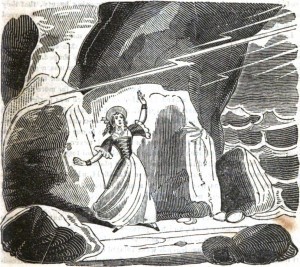
Watch out for that lightning! (from Angelina; or, the Mystery of St Mark’s Abbey)
George Reynolds’ long-running bestseller The Mysteries of London goes even further, elevating the darkness and obligatory storm into an ‘elemental war’:
The night was dark and stormy. The sun had set behind huge piles of dingy purple clouds, which, after losing the golden hue with which they were for awhile tinged, became sombre and menacing. The blue portions of the sky that here and there had appeared before the sunset, were now rapidly covered over with those murky clouds which are the hiding-places of the storm, and which seemed to roll themselves together in dense and compact masses, ere they commenced the elemental war.
And Wagner, the Wehr-Wolf adds sound effects – creaking trees, howling wolves and the roar of forest streams:
The night was dark and tempestuous; the thunder growled around; the lightning flashed at short intervals: and the wind swept furiously along in sudden and fitful gusts. The streams of the great Black Forest of Germany babbled in playful melody no more, but rushed on with deafening din, mingling their torrent roar with the wild creaking of the huge oaks, the rustling of the firs, the howling of the affrighted wolves, and the hollow voices of the storm.
Long story short: pathetic fallacy was MASSIVE in the 1840s.
3. On the other hand, 1840s entertainment was amazing
Many penny dreadfuls are set in the past – often a dark and threatening version of the Middle Ages (as in Wagner, the Wehr-Wolf, Angelina; or the Mystery of St Mark’s Abbey and Vileroy; or the Horrors of Zindorf Castle). But quite a few have a more contemporary setting, taking place at the time of writing or the recent past (for example, The Mysteries of London, The Life and Adventures of Valentine Vox and The String of Pearls, a Romance).
The contemporary novels almost all have an urban setting, which is usually London. These stories still have plenty of horrible settings to rival the Gothic castles, convents and ruins of the historical tales – lunatic asylums, prisons, seedy underworld drinking dens and the sinister kitchens of Mrs Lovett’s pie shop – but they also feature episodes set in the less gloomy world of polite entertainment.
Again, it’s Valentine Vox (which, I’ll admit, is my favourite serial of the 1840s) that has the most detailed description of the social engagements and entertainments on offer to a young ventriloquist-about-town in 1840s London. Valentine begins his tale at a magic show, where he learns about conjuring and – more importantly – ventriloquism. But that is only the start of his whirlwind tour of the delights of the capital.
Among his adventures, he goes to the Italian opera, travels on a steam packet day cruise and attends an Equal Rights march and a lecture on phrenology. He visits the British Museum, Guildhall, the House of Commons, the Victuallers’ fancy fair, a masquerade at Vauxhall, a waxwork exhibition, a concert by the Native Talent Association, a civic pageant and an exhibition of fat cattle. He also goes to the zoological gardens, Greenwich fair, the Royal Academy and Royal Ascot. All of these day trips and entertainments are described in meticulous – though rather ludicrous – description, and Valentine gets to try out the effects of ventriloquism on an array of unsuspecting audiences.
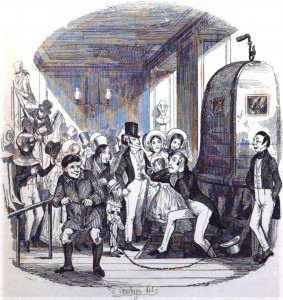
from The Life and Adventures of Valentine Vox, the Ventriloquist
My favourite episode comes towards the end of Valentine’s story, when he has the opportunity to try out a diving bell. It sounds awesome.
4. Werewolves are more badass than vampires
Okay… I already knew this one. But it’s good to have it confirmed.
There aren’t many vampires or werewolves in penny dreadfuls, but two of the best-known titles have one of these monsters as their title character. (It’s possible that these titles have remained well-known because of their monsters, of course.)
Varney the Vampyre; or the Feast of Blood is probably the Victorian penny dreadful that has found the most popularity with modern readers. It’s certainly the one that has the most modern editions (in paperback and eBook) and adaptations.
Varney the Vampyre isn’t so much a ‘classic’ vampire story, as a novel that sets the rules for the ‘classics’. It’s possible to see the influence of this story on Dracula and, a couple of generations later, on Hammer horror films. So many clichés of vampire cinema and literature can be found in Varney the Vampyre – dramatic storms, maidens in peril, puncture marks on the neck, pitchfork-wielding mobs. But, obviously, these weren’t actually clichés when the story was written. In the 1840s, Varney the Vampyre would have been an original and fresh story, drawing together Gothic tropes, the new fad for upper-class vampires that had been borrowed from German poetry and translated onto the British stage and page, and a little bit of pseudo-folklore.
It might come as a bit of a surprise to find that (and ‘vampires-as-monster purists’ might want to look away at this point) Varney is a sympathetic protagonist. Yeah – he’s definitely a blood-sucker, but he feels kinda bad about it. There are shades of Mitchell from Being Human in some of the vampire backstories told in the serial; there are moments of arrogance and pride that rival Lestat. But there’s also a whole lot of angst – maybe not quite as much as you’d expect from Edward Cullen, but enough to make you feel that it’s pretty hard being a vampire.
If that puts you off being Team Varney, have no fear – you can be Team Wagner instead. Wagner, the Wehr-Wolf is part of the much, much longer tradition of werewolf literature. But, unusually, there is a little bit less sympathy for its monstrous protagonist.
That’s not to say that Wagner doesn’t regret his lycanthropic ways or attempt to avoid causing wanton harm and destruction. But, ultimately, he is a monster. He made a rash decision that unleashed the beast within – and God help anyone who gets in his way.
Wagner, the Wehr-Wolf is a shorter narrative than Varney the Vampyre, but it’s a bit more bloodthirsty. If I had to face either of the protagonists in a dark wood at a full moon, I’d take my chances with Varney.
5. If in doubt, dress as a boy
The image of the Victorian lady is probably quite a familiar one to most readers. The Gothic maiden, dragged screaming and fainting into a world of dark horror, is probably also familiar.
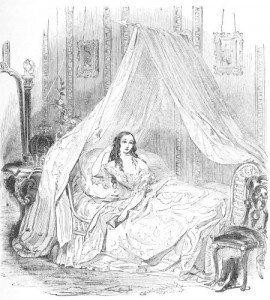
from The Mysteries of London (1st series)
Some penny dreadfuls do have heroines that fit the expected mould. Caroline Mecklenburgh from Vileroy; or the Horrors of Zindorf Castle finds herself trapped in an imposing castle, threatened with starvation, forced marriage, rape and murder, and eventually rescued through a combination of a male saviour, judicial intervention and her own courage and fortitude.
But not all the heroines of penny dreadfuls are so quick to lock themselves in a room and wait for outside help. When faced with the dangers of the world of men, a surprising number of young women decide: if you can’t beat ’em, join ’em.
Pierce Egan’s Wat Tyler has a girl who disguises herself as a boy in order to go to war. The String of Pearls, a Romance has Johanna Oakley who, after becoming convinced that the sinister Sweeney Todd had something to do with her lover’s disappearance, plans to dress as a boy and get a job with the barber.
The Mysteries of London, a very long-running and popular serial, has a vast cast of people living under assumed names, adopting new identities and wearing disguises. Almost no one is who they claim to be in this novel. So it’s hardly surprising that there are more girls dressed as boys in this narrative than in the others, or that more motives are given for this cross-dressing.
What is interesting, however, is that wearing men’s clothes is explicitly associated with bravery throughout Mysteries of London. For instance, when Ellen Monroe decides (with almost no provocation or explanation for her decision) to don male clothes in order to help out her unfortunate benefactor (Richard Markham), the narrator gives us this little picture:
The reader has, doubtless, seen enough of the character to be well aware that she had acquired a considerable amount of fortitude and self-possession from the various circumstances in which she has been placed: she was not, therefore, now likely to betray any diffidence or timidity as she threaded, in male attire, the crowded streets of the metropolis. She threw into her gait as much assurance as possible; and thus, without exciting any particular notice, she pursued her way towards the eastern districts of the great city.
There’s quite a nice little scene prior to this where Ellen goes to buy her suit and gets kitted out in dapper outfit, shoes, hat, gloves and neckcloth. It’s tempting to see the popularity of young, attractive women dressed in men’s clothes as a precursor to the male impersonators who would grace the music hall stage towards the end of the century.
6. Some things don’t change
As I’ve said, some of the penny dreadfuls paint a vivid picture of the characteristic quirks of the society that presented them (albeit sometimes seen through a glass, darkly). But every so often, a comment or episode chimes a little too well with modern society.
I’ll give just two examples here, both taken from The Mysteries of London. The first involves a knacker, explaining the fate of the horses he has to destroy. He reveals to an assembled group of horrified drinkers in a pub that some of the beef they’ve eaten may well have actually been horsemeat:
“What’s the use of all this here whining and nonsense, oh?” exclaimed the knacker. “Don’t I tell you that good horse-flesh answers all the purposes of beef, and is eaten by the rich in the shape of sassages and tongues? What’s the use, then, of making a fuss about it? How do you suppose the sassage-shops can afford to sell solid meat, without bone, at the price they do, if they didn’t mix it with horses’-flesh? They pays two-pence a-pound for the first-class flesh—and so it must be good.”
His audience (being British through-and-through) are appalled by the thought that they might have inadvertently eaten horseflesh, and horrified by the extent of the contamination. Sound familiar?
The second example will also be chillingly familiar. As the dodgy financial dealings of the numerous shady characters in Mysteries of London begin to come to light, we are introduced to Tomlinson, a banker (of ‘excellent’ reputation) who hovers continuously on the brink of bankruptcy. The narrative takes us behind the scenes at Tomlinson’s bank, to reveal the various practices through which the bank is able to survive. The reader is reminded repeatedly that a bankrupt tradesman would inevitably be sent to debtors’ gaol, but a banker without funds is always able to find ways to avoid arrest. Furthermore, a bank without money will lead to the downfall of any poor soul who had trusted them – but the bankers themselves will survive:
That is the invariable resource of all bankrupt bankers; and what is more extraordinary, they obtain confidence and succeed too.
Plus ça change…
For more information about the Hic Dragones Digital Periodicals series, please check the publisher’s website, like on Facebook or follow on Twitter.
September 30, 2014
WIN 4 Books, including SIGNED books by Ramsey Campbell and Douglas Thompson (International Entry Allowed)
Another Hic Dragones giveaway… this time with 4 fantastic books as a prize. Entry via the Rafflecopter widget below.

Impossible Spaces, edited by Hannah Kate (published by Hic Dragones)

Sometimes the rules can change. Sometimes things aren’t how they appear. Sometimes you can just slip through the cracks and end up… somewhere else. What else is there? Is there somewhere else, right beside you, if you could only reach out and touch it? Or is it waiting to reach out and touch you?
Don’t trust what you see. Don’t trust what you hear. Don’t trust what you remember. It isn’t what you think.
A new collection of twenty-one dark, unsettling and weird short stories that explore the spaces at the edge of possibility. Stories by: Ramsey Campbell, Simon Bestwick, Hannah Kate, Jeanette Greaves, Richard Freeman, Almira Holmes, Arpa Mukhopadhyay, Chris Galvin Nguyen, Christos Callow Jr., Daisy Black, Douglas Thompson, Jessica George, Keris McDonald, Laura Brown, Maree Kimberley, Margrét Helgadóttir, Nancy Schumann, Rachel Yelding, Steven K. Beattie, Tej Turner, Tracy Fahey
Obsession, by Ramsey Campbell (SIGNED COPY) (published by Samhain Publishing)
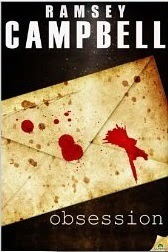
The deal seemed too good to be true. Until it came time to pay.
The letters said, “Whatever you most need, I do. The price is something that you do not value and which you may regain.” To four teenagers, it seemed an offer too good to pass up. They filled out the enclosed forms. Indeed, they soon got what they needed most, but in shocking ways they never imagined. Twenty-five years later, they have never been able to forget the horror. But it’s not over yet. In fact, it’s about to get much worse. Now it’s time to pay the price.
The Seven Days of Cain, by Ramsey Campbell (SIGNED COPY) (published by Samhain Publishing)
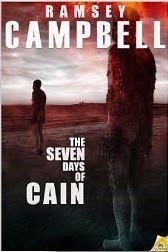
Is anyone really innocent?
On two continents, weeks apart, two people are brutally murdered: a Barcelona street performer and a New York playwright are each gruesomely tortured to death. In Britain, photographer Andy Bentley begins receiving mysterious emails. The messages refer to the killings and contain hints that the murderer has a personal connection to Andy. But what is it? Are the emails coming from the killer himself? And what, if anything, does Andy’s past have to do with the deaths? As the answers begin to take shape Andy will be forced to confront not only the consequences of his actions, but also the uncertainty of reality itself. Before that happens, how much that he loves will be destroyed?
Entanglement, by Douglas Thompson (SIGNED COPY) (published by Elsewhen Press)

In 2180, travel to neighbouring star systems has been mastered thanks to quantum teleportation using the ‘entanglement’ of sub-atomic matter; astronauts on earth can be duplicated on a remote world once the dupliport chamber has arrived there. In this way a variety of worlds can be explored, but what humanity discovers is both surprising and disturbing, enlightening and shocking. Each alternative to mankind that the astronauts find, sheds light on human shortcomings and potential while offering fresh perspectives of life on Earth. Entanglement is simultaneously a novel and a series of short stories: multiple worlds, each explored in a separate chapter, a separate story; every one another step on mankind’s journey outwards to the stars and inwards to our own psyche.
Enter now to win this fantastic prize…
August 1, 2014
OUT NOW: Hauntings: An Anthology (Hic Dragones, 2014)
A memory, a spectre, a feeling of regret, a sense of déjà vu, ghosts, machines, something you can’t quite put your finger on, a dark double, the long shadow of a crime, your past, a city’s past, your doppelganger, a place, a song, a half-remembered rhyme, guilt, trauma, doubt, a shape at the corner of your eye, the future, the dead, the undead, the living, someone you used to know, someone you used to be.
We are all haunted.
Twenty-one new tales of the uncanny:
The Conch
Rachel Halsall
Ghost Pine Lake
Brandy Schillace
Haunting Melody
Allen Ashley
Lever’s Row
Hannah Kate
Crying for my Father
Audrey Williams
The Man in Blue Boots
James Everington
A Handful of Dust
David Webb
Stella’s
Sarah Peploe
Focal Point
Michael Hitchins
First Bell
Patrick Lacey
Ghost Estate, Phase II
Tracy Fahey
A Place for Everyone
Rue Karney
Under His Wing, Poor Thing
Keris McDonald
The Foolish Light
Guy Burtenshaw
The Philosopher’s Way
B.E. Scully
Dreaming a Dream to Prize
Mark Forshaw
Professor Donaldson’s Séance
Stewart Pringle
Shifting Sands
Daisy Black
Moon Child
Mere Joyce
The Eight Pane Sash
Jeanette Greaves
The Anatomy of Mermaids
Elisabeth Brander
Hauntings: An Anthology is out now in paperback and eBook. For more information, or to buy a copy, please visit the publisher’s website.
July 16, 2014
Hauntings: An Anthology – Launch Party
International Anthony Burgess Foundation
3 Cambridge Street
Manchester M1
United Kingdom
Thursday, 31 July 2014
7-9pm
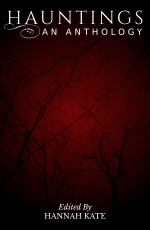
Come and join us at the launch party for Hauntings: An Anthology, a new collection of short stories from Hic Dragones.
Hauntings: An Anthology – twenty-one new tales of the uncanny
A memory, a spectre, a feeling of regret, a sense of déjà vu, ghosts, machines, something you can’t quite put your finger on, a dark double, the long shadow of a crime, your past, a city’s past, your doppelganger, a place, a song, a half-remembered rhyme, guilt, trauma, doubt, a shape at the corner of your eye, the future, the dead, the undead, the living, someone you used to know, someone you used to be.
We are all haunted.
Join us at the launch party on Thursday July 31st. Readings by: Tracy Fahey, Mark Forshaw, Hannah Kate, Sarah Peploe, James Everington, Michael Hitchins, Daisy Black and Rachel Halsall
Free wine reception, giveaways and launch discount on the book. For more information, please visit the publisher’s website.
Online Ticketing for Hauntings: An Anthology – Launch Party powered by Eventbrite
Summer Sale from Hic Dragones!
All paperbacks are £4.99 for the whole of July!
To celebrate the publication of Hauntings: An Anthology later this month, all our titles are now just £4.99 (plus p+p).

Check out our catalogue for more information about our titles.
June 13, 2014
WIN 3 BOOKS! Wolf-Girls Competition (International Entry)
A fantastic new competition from Hic Dragones…
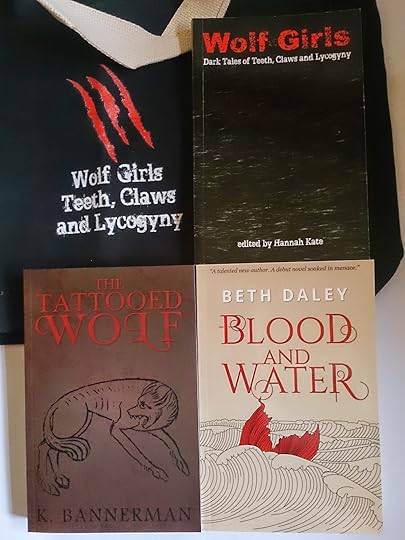
Enter now via the Rafflecopter widget below for a chance to win 3 wonderful paperbacks PLUS an exclusive WOLF-GIRLS tote bag!
Wolf-Girls: Dark Tales of Teeth, Claws and Lygogyny
edited by Hannah Kate

Feral, vicious, fierce and lost… the she-wolf is a strange creature of the night. Attractive to some; repulsive to others, she stalks the fringes of our world as though it were her prey. She is the baddest of girls, the fatalest of femmes – but she is also the excluded, the abject, the monster. The Wolf-Girls within these pages are mad, bad and dangerous to know. But they are also rejected and tortured, loving and loyal, avenging and triumphant. Some of them are even human…
Seventeen new tales of dark, snarling lycogyny by Nu Yang, Mary Borsellino, Lyn Lockwood, Mihaela Nicolescu, L. Lark, Jeanette Greaves, Kim Bannerman, Lynsey May, Hannah Kate, J. K. Coi, Rosie Garland, R. A. Martens, Beth Daley, Marie Cruz, Helen Cross, Andrew Quinton and Sarah Peacock.
In addition to this lycanthropic anthology, the prize also includes novels by two of the contributors: Kim Bannerman and Beth Daley!
The Tattooed Wolf
by K. Bannerman
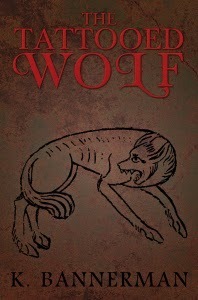
Morris Caufield thought he’d seen it all…
Until the moment Dan Sullivan walked into his office. Dan needs a divorce lawyer he can trust, and he thinks Morris is the man for the job. The thing is, Dan wants Morris to represent his wife. Who tried to kill him. Twice. And as if that wasn’t enough, Dan expects Morris to buy some crazy story about werewolves…
As Dan reveals the truth about his life and his marriage, Morris listens to a captivating tale of lycanthropy, love and betrayal. It’s lunacy, he’s sure of that, but there’s something about Dan Sullivan that makes it all very easy to believe.
Blood and Water
by Beth Daley

Dora lives by the sea. Dora has always lived by the sea. But she won’t go into the water.
The last time Dora swam in the sea was the day of her mother’s funeral, the day she saw the mermaid. Now she’s an adult, a respectable married woman, and her little sister Lucie has come home from university with a horrible secret. Dora’s safe and dry life begins to fray, as she is torn between protecting her baby sister and facing up to a truth she has always known but never admitted. And the sea keeps calling her, reminding her of what she saw beneath the waves all those years ago… of what will be waiting for her if she dives in again.
Enter now!
June 9, 2014
Coming Soon: New Digital Editions of Victorian Penny Dreadfuls
Serialized Victorian Gothic pulp fiction for the discerning modern reader!
 Hic Dragones is pleased to announce a new series of eBook editions of Victorian penny bloods and penny dreadfuls. Digitally remastered and reserialized, these editions are intended to introduce modern readers to the thrills, shocks and cliffhangers of classic blood-curdling tales.
Hic Dragones is pleased to announce a new series of eBook editions of Victorian penny bloods and penny dreadfuls. Digitally remastered and reserialized, these editions are intended to introduce modern readers to the thrills, shocks and cliffhangers of classic blood-curdling tales.
Penny dreadfuls have a significant place in the modern imagination and affections, but they are rarely read in the twenty-first century. And this is hardly surprising—with only a few exceptions, these texts can only be found in original publications or mechanically scanned copies. Until now!
The Digital Periodicals serials from Hic Dragones have been fully formatted (by a human being) to create searchable eBook texts with interactive tables of contents. For the first time since their original publication in the mid-nineteenth century, these texts will be sold as serials, with new instalments (comprising between 5-10 chapters) being released fortnightly. Readers can once again savour the anticipation of a new instalment, and enjoy these episodic stories as they were once intended.
Digital Periodicals launches on Friday 13th June 2014 with two of James Malcolm Rymer’s classic titles: Varney the Vampyre; or, the Feast of Blood and Vileroy; or, the Horrors of Zindorf Castle. Additional serials will be published in due course, with The Life and Adventures of Valentine Vox, the Ventriloquist coming out later in the month. As well as better-known titles, such as Wagner the Wehr-Wolf and The String of Pearls (Sweeney Todd), Digital Periodicals will introduce readers to works that have unfairly fallen into obscurity: including, George Reynolds’ Faust, Albert Coates’ Spring-Heel’d Jack and Pierce Egan’s Wat Tyler.
Penny dreadfuls were always meant to be pure, sensationalist entertainment, and the Digital Periodicals series is designed to inject the fun back into these under-read masterpieces of lurid, melodramatic, garish pleasure. Readers can subscribe to receive reminders about their favourite serials, and join in discussion about the stories on Twitter and Facebook.
Let the feast of blood begin again…
For more information, please visit the website or contact Hic Dragones via email. For academic and press enquiries please contact Hannah Kate (editor).
April 16, 2014
OUT NOW: K Bannerman, The Tattooed Wolf (Hic Dragones, 2014)
A fantastic new novel, edited by yours truly…

Caufield muttered as he slouched back in his seat and crossed his hands over his belly, smirking. “You’ve got my attention, Dan; I’ll humour you. Tell me, from the very beginning, how you got into this whole bloody mess.”
Morris Caufield thought he’d seen it all…
Until the moment Dan Sullivan walked into his office. Dan needs a divorce lawyer he can trust, and he thinks Morris is the man for the job. The thing is, Dan wants Morris to represent his wife. Who tried to kill him. Twice. And as if that wasn’t enough, Dan expects Morris to buy some crazy story about werewolves…
As Dan reveals the truth about his life and his marriage, Morris listens to a captivating tale of lycanthropy, love and betrayal. It’s lunacy, he’s sure of that, but there’s something about Dan Sullivan that makes it all very easy to believe.
Praise for The Tattooed Wolf
“[K. Bannerman] displays unusual and sometimes uncomfortable characters, and I care about them all, the significant players and the extras. If you like reading stories about intriguing people, this story doesn’t disappoint… buy this book.”
- Joe Murphy, The Dragon Page
K Bannerman lives in a tiny house surrounded by forests on Vancouver Island, Canada, where she writes short stories, novels and plays. She is the author of four novels, including the historical murder mystery Bucket of Blood. Together with her partner-in-crime, Shawn Pigott, they run Fox&Bee Studio, where they have written, produced and directed over 100 short films.
For more information, please visit the publisher’s website.
February 16, 2014
Win two amazing SIGNED books! (International entry allowed)
Another great competition from Hic Dragones… entry via the Rafflecopter widget below.
Enter now to win two SIGNED books:
The Palace of Curiosities by Rosie Garland
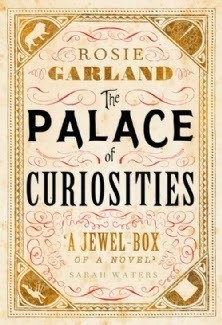
A luminous and bewitching debut novel that is perfect for fans of Angela Carter. Set in Victorian London, it follows the fortunes of Eve, the Lion-Faced Girl and Abel, the Flayed Man. A magical realism delight.
Before Eve is born, her mother goes to the circus. She buys a penny twist of coloured sugar and settles down to watch the heart-stopping main attraction: a lion, billed as a monster from the savage heart of Africa. Mama swears she hears the lion sigh, just before it leaps… and nine months later when Eve is born, the story goes, she doesn’t cry – she meows and licks her paws.
When Abel is pulled from the stinking Thames, the mudlarks are sure he is long dead. As they search his pockets to divvy up the treasure, his eyes crack open and he coughs up a stream of black water. But how has he survived a week in that thick stew of human waste?
Cast out by Victorian society, Eve and Abel find succour from an unlikely source. They soar to fame as The Lion Faced Girl and The Flayed Man, star performers in Professor Josiah Arroner’s Palace of Curiosities. And there begins a journey that will entwine their fates forever.
Rosie Garland is an eclectic writer and performer, ranging from singing in Goth band The March Violets through touring with the Subversive Stitch exhibition in the 90s, to her current incarnation as Rosie Lugosi the Vampire Queen, cabaret chanteuse, incomparable compere and electrifying poet. The Palace of Curiosities is her debut novel. Rosie’s short story, ‘Cut and Paste’ is published in the Hic Dragones Wolf-Girls: Dark Tales of Teeth, Claws and Lycogyny anthology.
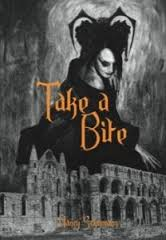
Take a Bite is a non-fictional text discussing female vampires in folklore and Anglo-American Literature and how their characteristics changed through the ages.
Readers will find a concise introduction to female vampires in folklore of various regions; with specific focus on the Lilith and Lamia figures that later on feature prominently in art and literature and including an overview on the numerous superstitions and phenomena that gave rise to vampire belief around the world.
Further chapters deal with the representation of vampiresses in literature and how this changed through the eras; starting with early romantic works such as Le Fanu’s Carmilla and Keat’s Lamia where the vampires is a strong, independent woman who does not fit into the patriarchal society.
Dracula puts female vampires in an inferior position, as the count takes centre stage. The discussion of Dracula focuses on the character of Lucy Westenra as a woman misunderstood by many critics.
The works of Tanith Lee and Anne Rice also include very interesting female characters. Anne Rice’s male vampires have been discussed excessively but her vampiresses deserve much more attention than they have received so far.
The Vampire Diaries are conquering TV screens and with True Blood and Twilight vampires are all around us, but is there a vampire queen among them or are we all just lusting after Edward?
Nancy Schumann completed a master’s degree in English Literature at the University of Leipzig, Germany. Particular research interests were Gothic novels, detective stories and women’s studies. Her MA thesis was on female vampires through the ages. The topic combines feminism and Gothic novels with her personal interest in fanged fiends. This formed the basis to Take A Bite, now available in vamped up form for public consumption. Nancy’s short story ‘The Hostel’ was published in the Hic Dragones Impossible Spaces anthology.
Enter the competition…


